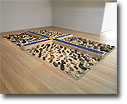Peabody Essex Museum,
Feb 19, 2005 - Jun 05, 2005
Salem, MA, USA
Island Thresholds
by Madeline Medeiros Ruiz
The first gallery groups the work of David Boxer and Marc Latamie. Boxer’s art focuses on the history of slavery and the slave trade and the consequences this past has had on Jamaican culture. Works like The Black Books (1992-2003) and the painting Passage II (The Wounded Sky) (1994) explore the darkest and heaviest of realities of Jamaica’s brutal past by incorporating both specifically Jamaican cultural references and universal imagery symbolizing the oppression of African peoples through the slavery and plantation life.
On the wall opposite from the gallery’s entrance hangs Transatlantic (1996-2001) a grouping of 50 works pinned to the gallery wall, floating in a formation that mimics the shape of an island landmass. Each page, many representing US states, contain watercolor figures, flowers and abstract imagery. The cultural references, European, African, South American, are displayed across the pages, representing a cross of cultures, epochs and ethnicities across this imagined island. There is a sense of memory and history evoked in the drawings, as casual and free-form as they are, in direct contrast to the ultra-precise renderings of mountain formations and city borders found on the original maps. Latamie’s own experience of transcontinentality, born in Martinique and having studied in Paris and now a resident of New York, is highlighted precisely in this piece.
In the second exhibition room, Capellán’s La Bandera de los Ahogados (1996) is spread across half the gallery floor. The sometimes overly stated symbolism of Capellán’s socially conscious art work of the past decade is represented here by a Dominican "flag," compiled from salvaged shoes from the shores of the Dominican Republic, sand, seawater, an oil lantern and wood. The flag’s cross is created out of two intersecting wood channels filled with seawater. At the center floats a burnt out lantern. The flag’s four quadrants are made from a bed of sand, with the recovered shoes - adult and child sneakers, flip flops and sandals - all pointing away from the flag’s center. The installation functions as a memorial to those who have died trying to cross from the Dominican Republic to Puerto Rico through the 80 mile passage named "Mona Passage." At the center of one quadrant, a baby’s sneaker sits at the center, with a shiny "Pooh Bear" smiling at the viewer- a direct and chilling juxtaposition of innocence and youth, with the harsh realities of peril and death.
Capellán’s second piece in the exhibition is Mar Caribe (1996). From afar, the work is a seemingly innocuous circular pattern (symbolic of cyclicality, endlessness, constancy) of flip flops in varying hues of blue and green reminiscent of the Caribbean Sea itself. Upon approach of the mesmerizing pattern, one’s initial sense of comfort is replaced by discomfort and concern: the sandals creating the undulating pattern so indicative of calming waters, have been manipulated by the artist - the soft plastic tongs of the flip flops have been replaced by sharp barbed wire. A very similar work (instead of a circular shape, the sandals were arranged into a rectangular shape) was shown at RISD’s Island Nations show a few months earlier, lessening the appeal of this smaller version. It seems unfortunate that other work by the artist was not chosen instead, given the small size of the show and this obvious overlap by the two institutions.
One of the most intriguing works is Latamie’s Ajoupa (2004). Named after a sugar growing and rum distilling village in northern Martinique, this narrow, wooden one room house-like structure displays various natural spices and herbs native to Latamie’s country of origin. Upon entering the house, small tin bowls with thin wire mesh placed delicately over the tops are laid out along shelves at the edges of the two side walls. At each corner of the house hang rolls of cinnamon, vanilla and other engrossing spices. The cramped space and small dishes encourages close proximity between visitor and spice - as you lean in to take in the scent of the unlabeled dark powder the smell of cocoa and wood immediately recalls one’s own memories. The purity of the smell may even be foreign to those whose only contact has been with processed versions of these basic ingredients. The work is at once universal and local, as each visitor to Ajoupa conjures up their own memories, while also considering the memories of the artist which would lead to the creation of a work such as this. While simple in construction, the work as a whole is both beautiful and powerful in its ability to incite memory and emotion. The dark powders spice shavings displayed on simple ledges like specimen in this quasi-alchemist shop functions as an extremely potent relational project.
|













